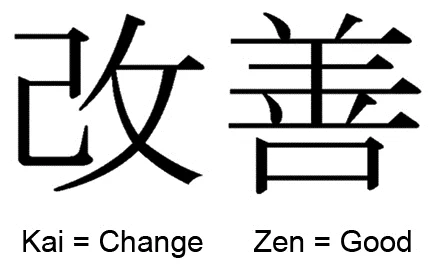Tag: performance
From old to new routines
ARE YOU WITH ME… JUST READ FURTHER…

With the arrival of new individuals, organizations can view existing processes and routines differently. This creates space for the organization to adapt to changes.
Continuous improvement as a routine
Employees are increasingly asking employers to renew their work. They are becoming more assertive and also opting for alternatives if they don’t like it. Moreover, more and more organizations are seeing that not all old ways of working still serve them. As a result, organizations face the challenge of operating more efficiently and flexibly. With the arrival of new technologies, services and products, it is also possible and better needed to improve. Motivated employees who actively evaluate and improve their work processes increase the competitiveness of the organization. The condition here is that continuous improvement becomes routine in the workplace.
Constant change
To be able to keep innovating constantly, the right culture and infrastructure in an organization is required. The management of employees by management is changing. Employees are given more room to excel themselves and teams are put together more to innovate together. It’s about the right balance in this. The framework must therefore be very clear. Both the output that is requested from employees, the people who can participate in innovation, and the time that is available for it. This requires a rigorous break with routines.
To break through routine, it is important to look with the employees at how we approach work and where improvements can be made. Activity Based Working has proven to be a very effective tool for this. Some examples are;
1. Increase the control space
Work, where, when and how you want. For this it is important that the employee has the same things at home as at the office. There is a need to digitize . A clear framework about what is allowed for the individual in collaboration with his colleagues and clarity about his / her output. This not only helps to break through routines, but also to greatly increase employee productivity and well-being.
2. Improve the office
How important is the office space with permanent workplaces in 2019? Does there still have to be an office or does that serve as focus space? Is there a large room where everyone sits together or are there many separate rooms where you can call or hold meetings via video ? It is important for employers to see whether or not they should invest in the office building in the future or in other options. By talking to employees about their routines and discovering together what the new way of working looks like, you gain new insights. Based on those insights, you can create a fantastic functional office building where people feel more at home, more satisfied and proud of their employer.
3. The performance of employees
Performance interviews are often held in a separate room, in a static position. The employee sits opposite the employer, just as with the application at the start. This immediately creates a certain atmosphere. This has an effect on the course of the conversation. If employees get more daily control and there is more room for feedback. Then functioning is no longer a heavy subject. It’s a conversation that everyone knows what’s coming. That is why it is best to also conduct this in a transparent room or in the open air. The space, but especially the openness, make a substantial difference.
Giving employees space and, where necessary, guiding them makes them feel heard and connected to the organization. Breaking routines, giving space to people and having an open work culture are only benefits for many organizations. And Activity Based Working is a perfect tool to take a big step in that. The success of every organization is hidden in the daily routine. So don’t get stuck in old habits.
STOP EATING ONLY CHAMPION CHOWMEIN ONLY. TRY NEW THINGS STEADY STEADY.
After 100 days it is goodbye 2019

Just like nature, time is ruthless. Another 100 days and then 2019 is over. What goals did you have for this year? Are you happy with what you have achieved this year? Have you made good use of your limited time on this globe and have you improved the quality of your business, your health, your state of mind and your relationships? We're just a flash here. Such a sin if you are mainly busy with it in the flash: • putting out fires • hunting for to-do's • numbing of pain • filling void with even more void • hunt for recognition • working hard on the wrong • working hard in the wrong way • achieving success without satisfaction To die then. Without ever having really lived. 2019 still has 100 days. Did you get it? What are you going to do with that? And do you have a concrete plan for 2020 or will it be more of the same? Find out how you can get more out of yourself and mean more for your company / organization, so that you can get more out of your life. Because a Lamborgini for your door is cool. But together with the love of your life, a fit body and a big smile on your face in a Lamborgini towards the next adventure is much cooler. There are certainly steps you can take now for a strong end to 2019, and start immediately with a lead in 2020. You can let me know what you are going to do to get the most out of yourself. 2020 is coming.I am prepared !!

Improve by 1% Percent at a Time

For people who would like to improve on a personal level, there is a widely used Japanese method: Kaizen. Kaizen revolves around the small steps that must be taken to realize the biggest plans. In my daily activities I am using the KAIZEN spirit and techniques to become better: Getting one percent better every day is a simple, practical way to achieve big goals.
Kaizen spread to the rest of the world thanks to American experts such as Frank Bunker Gilbreth and Frederick Winslow Taylor. They were already at the forefront of research into effective work in the 1920s and their knowledge was the basis for Kaizen. In post-war Japan, a way was sought to increase the effectiveness of employees. This way was found in the idea of Kaizen, freely translated: good change or continuous improvement.
More than just improvement
Kaizen has a goal that goes beyond just improvement. It is a daily activity and a process that can make people more human. It eliminates unnecessary work and teaches people to see wastes and remove them. A commonly used definition is ‘disassembly and reassembly in a better way’. What is taken apart is usually a process, system, or service in a company. In personal development, an action or habit will be reassembled.
Accessible
Continuous improvement works by sticking to three conditions. Set a goal for one percent improvement. Decide how often you will work on the goal and stick to that plan, focus on the one percent improvement. Stay with this process until you reach the end goal. By not focusing on the end goal but on the one percent goal, improvement can be achieved in an easily accessible manner. By working in small steps you build a solid foundation for a great future.
WHY NUTRITION, SLEEP AND EXERCISE ARE IMPORTANT FOR SUCCESS
No matter who you are, but as human I like to share the following with all of you…
Be honest: how well do you take care of yourself? Or are you also such a hard worker? The care for your health should actually come first, even before your work. If you are not healthy, you can not be successful. In this way, nutrition, sleep and exercise (not) contribute to your success:
Nutrition If you are at work from early in the morning, you will have a raging hunger at lunchtime. You long for a hearty lunch, such as a thick slice of bread or pasta salad. Whether you give in to high-calorie food, such as a croquette. Recognizable? Have you ever thought about what a carbohydrate and calorie-rich lunch does with your productivity? A few hours later, the inevitable energy dip follows. For that reason, many people drop in at noon. Research shows that if you eat more fruit and vegetables during lunch, your afternoon is not only more productive. You also feel more involved in your work and even happier. The best you can eat in the course of the morning,so that you have enough of a tasty salad with fresh vegetables or fruit during lunch.
Sleep
Work can take a lot of time. Do you already work before the sun goes up and do you stop working when the sun is (almost) under? Do you check your email in the evenings or do you just walk behind the computer to finish something after dinner? Small chance that your body gets enough rest. Rest is important, because a sleep deprivation can not only lead to more stress. You can also suffer from your cholesterol. A lack of sleep can even lead to reduced cognitive abilities. In other words, your performance will suffer if you do not get enough rest. What to do? Maintain fixed work and sleep times. Get up when the alarm goes off and plan some time at the end of the day to let go of your work. Avoid sleeping late, because then you disturb your sleep rhythm.
Movement
Exercise helps to relieve stress and to get away from daily worries at work. In addition, sports protect you from depression and other mental barriers to success. Often it does not work to allow yourself to go for a walk during the lunch or to exercise as soon as you get home. In the issues of the day you forget your intention easily. In the evening you often give priority to your work (or TV). Therefore make movement a part of your daily schedule. Put in your agenda for half an hour to an hour and stick to it. After exercising you feel lighter, more energetic and happier. You can do more physically and also mentally you can have more. That too contributes to success.
What are you doing to take care of yourself? Share it below in the comments!![]()
![]()
![]()
![]()
![]()
![]()
STOP BRAINSTORMING
![]()
![]()
![]()
![]()
![]()
![]() This blog is sponsored by FUTURENET CARIBBEAN sign up here with the link
This blog is sponsored by FUTURENET CARIBBEAN sign up here with the link
Organizations need creative ideas to grow and innovate. Employees are creative because they have expertise, are motivated and can think well. Teams are creative because they benefit from the synergy between people. The most common method to turn that creativity into something concrete is the brainstorming. But that method actually does not work at all.
Brainstorming was devised by Alex Osborn in the 1950s. It has four rules:
- You must generate as many ideas as possible.
2. You must give priority to unusual and original ideas.
3. You must combine and refine the ideas
4. You can not criticize the ideas during the brainstorming session.
This informal and unstructured process is based on two ancient theories from psychology. Namely that the presence of others has positive consequences for people’s motivation and that quantity leads to quality. Osborn even claimed that brainstorming would lead to fifty percent higher performance. But his theory has been studied for almost seventy years. What seems? Brainstorming produces no better and no more ideas than if all individual employees would work independently. In fact, there are even indications that brainstorming damages creativity.
Why brainstorming does not work
In a survey more than 800 teams were analyzed. The conclusion was that individuals produce more ideas when they do not interact with others. Brainstorming mainly damages the larger teams. Especially if they are subsequently also under a magnifying glass from a manager and if the ideas must be handed over orally instead of in writing. Moreover, teams give up faster when they notice that all their efforts do not yield anything.
There are four explanations for this. First, there are always people in a team who do not really commit themselves. They do not do their best and deliver little. This is the result of a psychological phenomenon known as the bystander effect. We are less likely to do something if we know that others can do it too. In addition, people are also afraid of what others might think of their ideas. If there is someone who is very good at a brainstorm, the rest may think they are not good enough. This reduces the overall performance. This effect is even stronger if someone is introverted or insecure. Then there is the human tendency to find an average. The best in a group adjusts its performance downwards, until the average of the group is reached. We often see this in sports teams when they play against a much worse opponent. They lower themselves to the level of the opponent. Finally, there is the fact that, no matter how large the group is, we can only introduce one idea at a time. The amount of ideas reaches a plateau when there are six to seven participants in the group. After that the total amount of ideas remains the same, and the amount of ideas per person falls.
Why we still brainstorm
But why is there so much brainstorming? This is probably due to the ever-increasing specialization in the field of work in organizations. The expertise is divided equally among the team members. If a problem needs to be solved that requires different levels of knowledge, it is important to put together the brainstorming group in the right way. As a result, the available knowledge is more diverse and the problem is highlighted from several perspectives. This benefits the solution. In practice, participants have to be carefully selected for a brainstorming session.
Much coordination and coordination is also required. If you have ever been to a brainstorming session, you know that that is not always the case. Even if groups do not produce more or better ideas, a brainstorm is more democratic. As a result, employees may feel more involved and use the solution sooner. Whether that solution has quality or not.
It comes down to the fact that brainstorms are still used to do what feels intuitively well. It is a wonderful placebo in the arsenal of a manager. It should work even if there is no evidence that it really works. So go ahead and put that brainstorm in the agenda. You can not achieve anything with it, but your team feels better.




